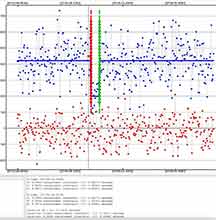


This difficult event lasts up to 23 seconds long, making long integrations possible and still valuable. With fog below and no moon, and the target in the dark NE direction from Grant park up Mt Hamilton Rd, this may well be do-able. I'd recommend a full 1 second integration (64x). Maybe even 2 seconds 128x depending on conditions.
The target is in Auriga, 35 degrees up at Az = 77.
 |
 |
 |
Kirk carpooled with me to escape some wild high level fog. Given the value of Trojan asteroid events with the Lucy Mission spacecraft on it's way to the Trojans right now, I decided we'd go wherever we had to in order to get observations. There was also the Industria occultation 2.5 hours earlier, and the paths didn't overlap until farther north, near Lick Observatory. This was the only location promising to get above the fog and be able to possibly get both events, so I invited Kirk to join me on a Mt. Hamilton ~all nighter.
However, I was itching to get in a trail run, and what with calculations and etc, I didn't get to leave for Fall Creek until early afternoon, didn't get on the trail till 3:30pm, and worse, I got over-pleased with the pleasure of trail running and took an extra few miles into a run I'd thought would be 6-7 miles, then 10 miles, and ended up being 13 miles. I got back home at 7:30pm, madly got stuff together while throwing on some pasta, emailed Kirk to be at my place with gear by 8:40pm. We got out at 8:55pm, and a needed gas fill up (I tried in Felton first, but the Qstop was yellow-taped closed) was balky and that added delay as well. I still hoped the early satellite images of no fog in San Jose and none on Mt Hamilton Rd would hold, and that we could set up at Joseph Grant county park for Kirk, and me a bit farther up the road. Alas, the fog dogged us to the end, and we had to keep climbing up the winding road. Last possible chance was Twin Gates trailhead (top of the 2nd climb) at 2350 ft elevation. We broke through the fog tops as we approached, parked, and madly got our gear deployed for a double telescope attempt for Industria at 10:25pm. Everything went as well as possible.... but we still didn't get the tracking scopes on target until 5 minutes after the event. Doh! Missed by only 5 minutes! We took some night shots, could see Lick Observatory maybe 5 miles as the crow flies (10 miles as we drive) and it made for some nice pictures with the Hyades and Mars rising over the mountain and domes. A few other amateur astronomers were there at Twin Gates as well, and we chatted, then packed up and headed further up the mountain as it felt chilly and damp and the fog was still a danger. We pulled off at the big oak tree clearing at a bend in the road about 2-3 miles above the fire station, and at 3,000 ft or maybe a little more. Here it was dry and air was warmer - marine layer finally escaped! I positioned the car to block headlights for oncoming cars, and suggested we pile our empty scope boxes onto the car roof to further block headlights, as the target star was directly over the oncoming down-driving cars. There were very few cars and they ended up not being an issue during the occultation.
Kirk used Polaris as one of his alignment stars and got a good align and tracking. I used Capella and Fomalhaut and for whatever reason, got a poor alignment and running out of time to try and start over. My pointing did not position the chart stars on the Q70 eyepiece, and worse, there was an asterism of bright stars at the target which turns out to be almost precisely duplicated 1 degree away, and where my scope ended up pointing. I just knew that was the right asterism and was frustrated nothing matched when swapping in the Watec. In the end, I did not get data. Only afterward, did I search more widely and found the target and realized the red herring asterism. I should have photocopied a wider field around the LCD chart, but didn't because I knew it would be important to be sure we used a big enough integration to see the target, which was not on the charts (at 15.9 magnitude - dimmest we'd yet tried with our 8" scopes). Anyway, I got nothing. But Kirk had the superior camera and good positioning, and it all worked! He got a 17s event, clearing the false positive criterion easily, so all's well that ends well I supposed. W/o me driving, I don't think any of us would have gotten data.
Ted Swift had a cloud lose a precious magnitude off his already challeneged look through the light dome of Davis and Sacramento, and from ~sea level air density. Driving up Mt Hamilton definitely helped, and it was very dark up there, with San Jose and Bay Area lights reduced to just a dim gray cloud below. Kirk's event was 13 seconds after the nominal central event prediction for Santa Cruz, but that's the ~same as the 1-sigma prediction time error, so nothing unusual. Central actual occultation for us on Mt Hamilton as 7:55:28 UT
 |
 |
 |
 |
 |
 |
magDrop: 0.813 +/- 0.160 (0.95 ci)